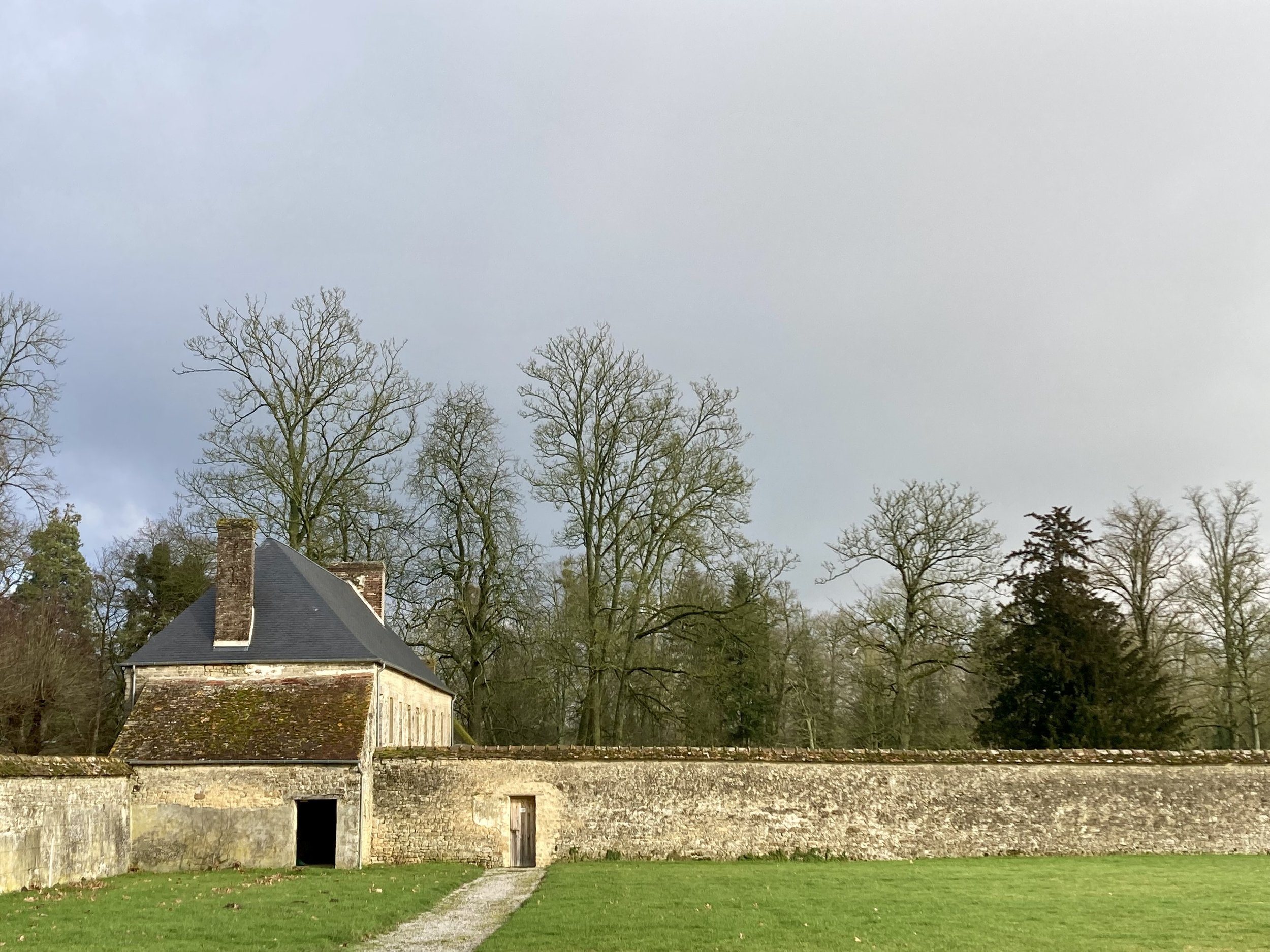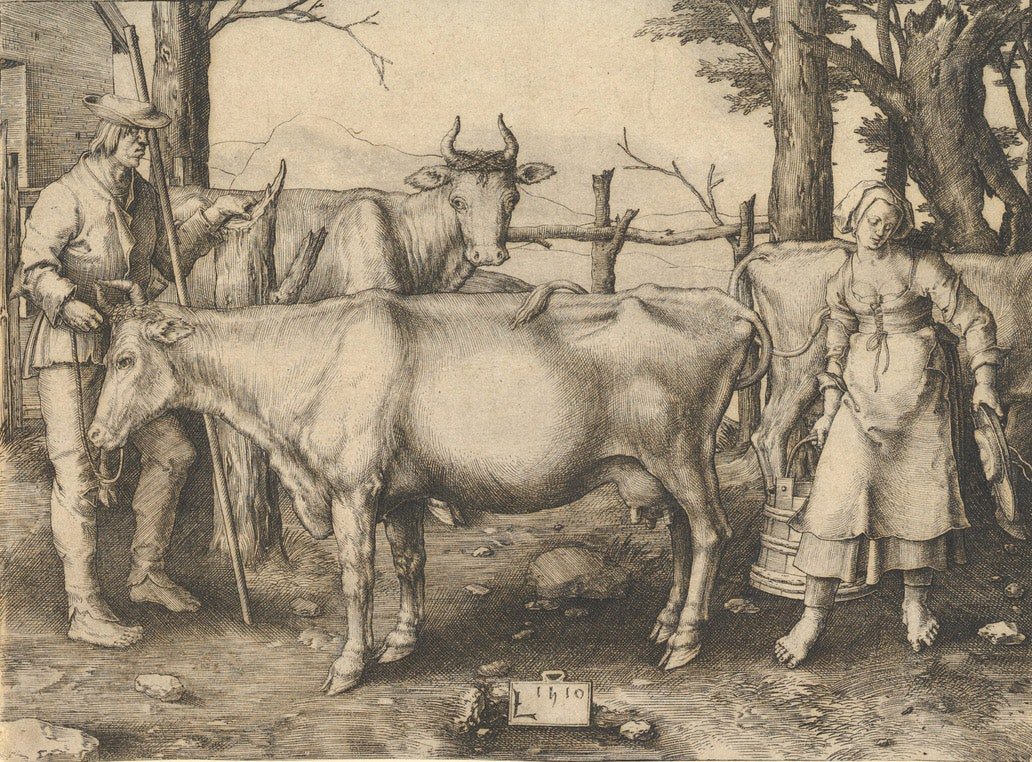Winter at the Farmhouse
A new perspective on life in the "basse-cour"
Winter morning in the "basse-cour," looking over the wall toward "le Fleuriste," the Orangerie, and the woods of the park.
Saturday, February 12, 2022
Chère amie, cher ami,
A delicate pink washes the morning sky, transparent and thin above the black limbs of leafless trees. Buried low in the horizon, the sun is slowly rising, hidden in a golden red cloud, barely visible amid the thick growth of the woods.
The first birdsong begins: the cheerful rouge-gorge, the whistle of the merle noir, a few chirps from the grive, which saves its song for "les beaux jours" of springtime. And from the stabulations on the other side of the granges that make up the rectangle of the "basse-cour," the farmyard, the cattle are stirring.
It’s time to light the fire and make coffee. And to step outside for a matitudinal turn in the fresh cold air.
We took up winter quarters in the Farmhouse with a vague and pleasant idea that it would be cozy and warm. It is, especially in front of the broad stone hearth, piled with logs and crackling brightly.
But being here has also opened new perspectives, as if we had come upon a forgotten photo album that shows us previously unnoticed objects and views. The Chateau falls into the background, masked by the high walls of the basse-cour and the roofs of the “fleuriste” and the Orangerie. Here, we are close to the woods that border the Great Lawn of the park. There’s a stream and its fontaine, the burbling spring. An old road through the pastures leads to a marécage, a swampy and impenetrable half-acre that harbors deer and birds. And we are close to our livestock.
We always took a lively interest in the well-being of our cattle. For as one reads in the old French Bible found in the Chateau’s library, “Remarquez avec soin l’état de vos brébis & considerez vos troupeaux!” (“Be thou diligent to know the state of thy flocks, and look well to thy herds!”).
Monsieur Jean-Yves, who follows this biblical exhortation with the instinct bred into generations of Norman farmers, lets me know on a regular basis how our bovine world is faring. Morning and evening, either he or his son feeds the herd. He and his wife, Madame Brigitte, keep a monitor in their bedroom to alert them when a cow goes into labor. And for our part, we enjoy looking out at the ruddy Limousine herd grazing in the pastures, or walking home to be fed at night, in a long single file led by a venerable dowager.
A print by Dutch artist Lucas van Leyden shows a scene of farmyard life from 1410.
But this newfound proximity has awakened a different kind of feeling toward the troupeau. These mornings, I find my steps wending toward the big open stables where the les bovins are kept in the winter months. The young cattle surge over to the rail above their manger in a rustle of curiosity. The older cows, less impressionable, lift their heads briefly. Then, satisfied and indifferent, they return to the serious business of ruminating. A wobbly young calf stares out from the protection of a mother’s flank.
Our youngest bull, not even two years old, just arrived at the end of the summer. He is called Romulus, because he was born in the “R” year of 2020. He stays with a small group of cows who will be first-time mothers this spring. In their midst he loiters, still plump and rather small, his body still soft and curly-haired, and they treat him like a little brother.
“We don’t want to wear him down,” Monsieur Jean-Yves told me, turning a calculating gaze on the young bull. “He still has a lot of growing to do.”
Romulus snuffles one’s hand with a moist muzzle. His wide eyes are a soft brown.
“Monsieur Pierre led him off the trailer with nothing but a halter,” said our farmer approvingly.
Monsieur Pierre is the breeder from whom we bought our original herd. We continue to buy our bulls from his farm down to the south, close to the berceau de la race, the cradle of the breed in the old province of Limousin. Pierre’s great-grandfather helped found le Herd-Book Limousin in the 1880s. Pierre, in his view and ours, has maintained the best of the vigor and form of the original bloodlines. And his ruthlessly breeds out les fiers, those with a fiery “proud” temperament.
Meanwhile, Ned, who will be five this year, shares a shed with the older cows, the ones who might be too hard on a young bull lacking in confidence and strength. He is large, muscular, stately, and has been admired so often that he habitually strikes a pose that shows off his strong, straight back, swelling shoulders and neck, and well-rounded culotte. He weighs well over 2,000 pounds. Under the stiff curly hair of his forehead, I can feel the heavy bone. Just in case he should forget his noble origins and start pawing the ground like a toro in a bullfight, Ned wears a ring in his nose. But Ned is gentle. He accepts a final caress, and swings away to bestow a mild snuffle on one of his consorts.
I turn back to the Farmhouse. The sky has grown blue, mottled with fading swathes of rose and silver. Smoke rises from the chimney. Sunlight glances cheerfully off the windowpanes, beckoning me in.
I’m quite fond of those bovines, I reflect contentedly, taking two cups from the buffet à deux corps and preparing a café au lait for myself and Monsieur. And so begins a winter morning at la Ferme…
A très bientôt, chers amis!
Elisabeth
Our farmer’s son with the vet and her assistant, treating the herd on a sunny afternoon a few weeks ago.
www.chateaudecourtomer.com info@chateaudecourtomer.com
P.S. Heather or Béatrice (info@chateaudecourtomer.com and +33 (0) 6 49 12 87 98) will be happy to help you reserve your holiday or special gathering at the Farmhouse or the Chateau. We still have a few openings for this year and are taking bookings through 2024. Please feel free to call or write us.



